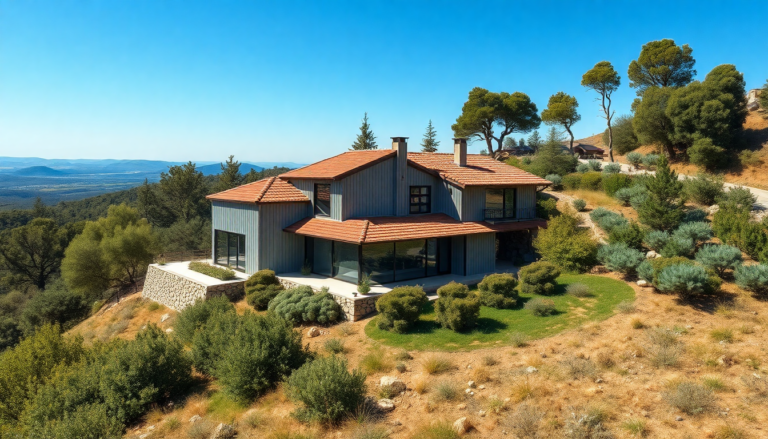Argomenti trattati
It’s no secret that wildfires are becoming more frequent and intense, threatening homes across the United States. In fact, a staggering 35% of homeowners reported increased wildfire risk to their properties according to Hippo’s annual Housepower Report. As someone who has seen firsthand the devastation caused by wildfires, I understand the urgency of making our homes safer. With house fires causing billions in damages, what can we do to enhance our home’s resilience? Here’s a deep dive into innovative strategies for fire-resistant home construction.
Choosing the right materials
When it comes to safeguarding your home, the choice of materials is crucial. Fire-resistant materials can significantly slow down the spread of flames, providing precious time for occupants to escape and for firefighters to respond. Think of materials that are non-combustible and heat-resistant. For instance, roofing is a key component. Opting for fire-resistant underlayment and ensuring tight seams can make a world of difference. I still remember helping a neighbor replace their roof with Class A rated materials; the peace of mind it brought was palpable.
Next up, the exterior walls. Materials like fiber cement or stucco offer better protection than traditional wood siding. And don’t forget about windows and doors! Tempered glass windows can withstand high heat and impact, which is crucial when embers start flying around. It’s all about creating layers of protection.
Designing fire-resistant spaces
But it’s not just about materials; design plays a pivotal role, too. Strategic design elements can help create firebreaks and slow the spread of flames. Think about incorporating draft-stopping solutions. Using fire-rated caulks and intumescent sealants around pipes and wires can seal off small openings that could allow flames to spread. I once visited a home designed with a ‘defensible space’ concept, and it was impressive how well it was protected.
Investing in fire-rated walls and floors can also be a game-changer. These barriers can contain a fire’s point of origin, ensuring that your whole house doesn’t go up in flames due to one small spark. It’s like giving your home a safety blanket!
Innovative sprinkler systems
Sprinkler systems are another fantastic addition to any fire-resistant home. The cost of installing these systems is surprisingly reasonable, often around $1.35 per square foot for new constructions. They can be integrated with your home’s plumbing or operate independently, which is pretty neat! I remember chatting with a contractor who emphasized that having individual sprinkler activation technology can minimize water damage by only activating the nearest sprinkler to the fire. It’s efficient and effective.
Regular maintenance is key, though. Homeowners need to check the water pressure, clear any obstructions from the sprinkler heads, and schedule periodic inspections. It’s a small price to pay for peace of mind.
Fire compartmentation techniques
Another essential strategy is fire and smoke compartmentation. This involves using fire-rated walls, doors, and ceilings to contain fires within specific rooms, preventing them from spreading. High-risk areas like kitchens and garages should be compartmentalized using fire-resistant barriers. I once attended a seminar where a fire safety expert stressed the importance of self-closing fire-resistant doors. They’re a simple yet effective way to isolate fire-prone areas and limit the movement of flames and smoke.
Sealing gaps created by structural elements is also vital. This helps prevent fire from sneaking through those small openings. And don’t overlook the importance of sealed attic and crawl space barriers; they work wonders in containing smoke.
Weighing the benefits and challenges
Incorporating fire-resistant features into home construction offers numerous advantages. A fire-safe home provides not only protection but also peace of mind. Many insurers recognize these measures and often provide discounts on premiums, making it an attractive long-term investment. However, it’s important to acknowledge the challenges as well. These features can increase upfront costs and may be harder to source. Balancing safety with budget constraints is an ongoing challenge for builders.
Adapting to local risks based on fire likelihood and building codes is essential. Resources like NFPA codes can guide builders in meeting regulatory requirements. I’ve seen how builders who proactively embrace these regulations end up creating safer, more marketable homes.
Creating a defensible space around your home
One of the most effective fire-prevention strategies is establishing a defensible space around your home. This buffer zone not only slows down the advance of fire but also provides firefighters with a safer area to operate. Think of it as your home’s first line of defense. Regularly clearing vegetation and debris is crucial—remove anything that could ignite and spread flames to your home.
Ensuring you have accessible water sources is also a smart move. Long garden hoses or large containers of water can be life-savers in a pinch. It’s about being proactive rather than reactive. As the saying goes, “an ounce of prevention is worth a pound of cure.”
As we navigate a world where wildfires are increasingly encroaching on our neighborhoods, understanding the risks and taking proactive measures is not just wise; it’s essential. The future may seem daunting, but with the right strategies in place, we can protect our homes and loved ones.

